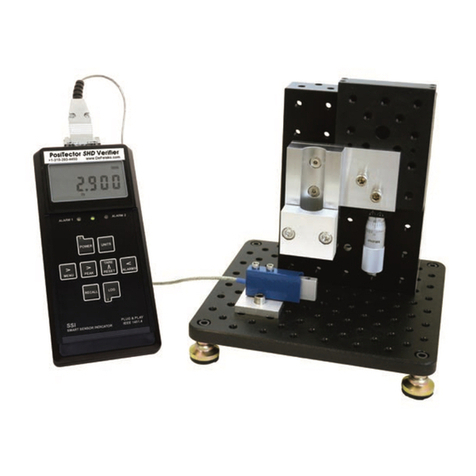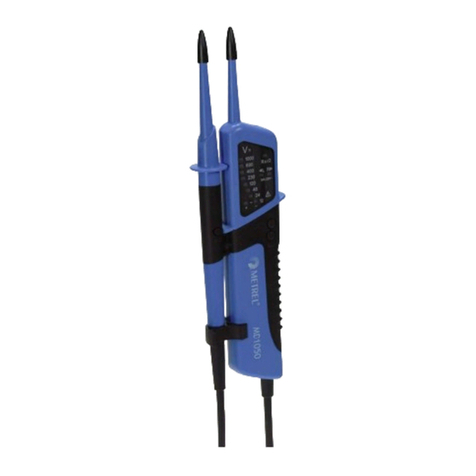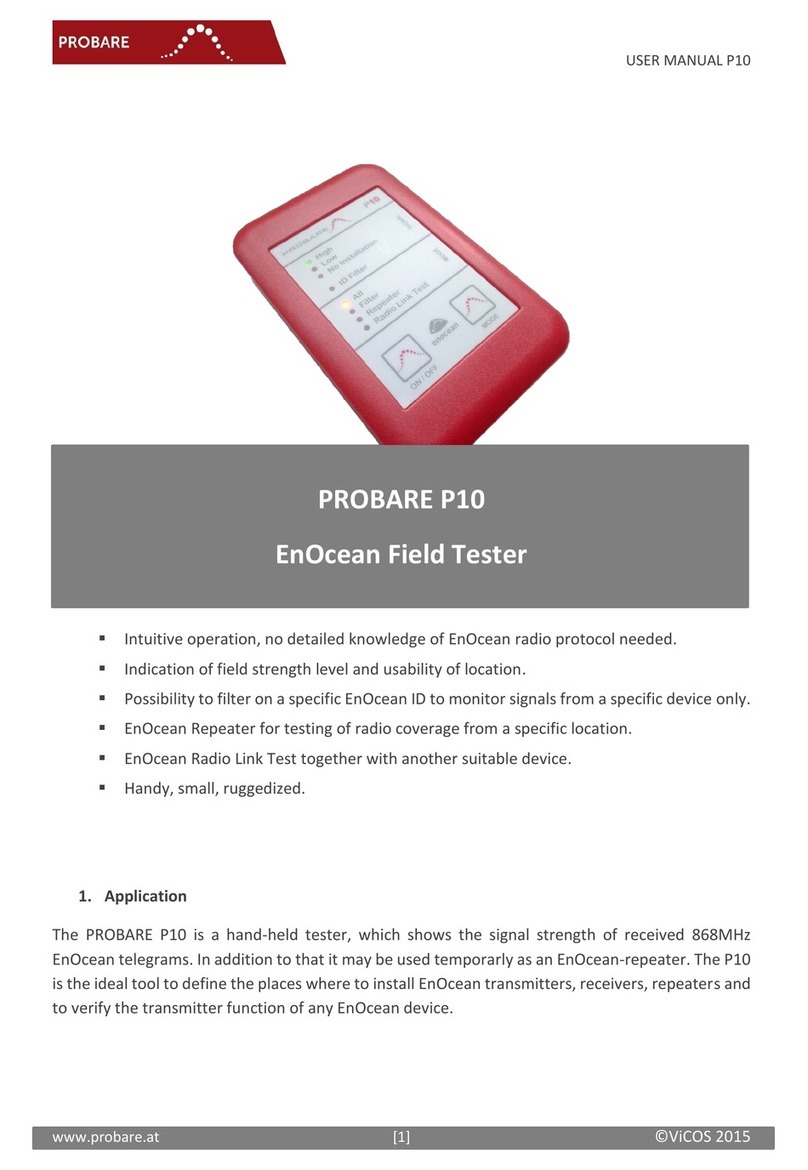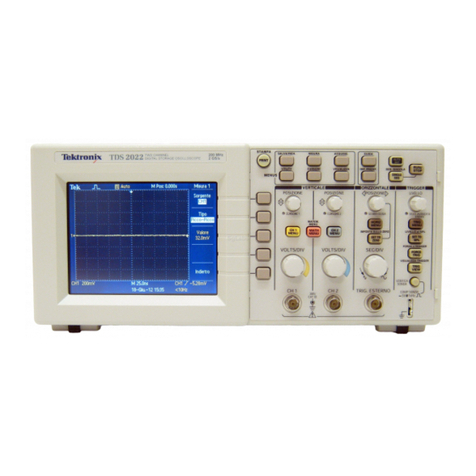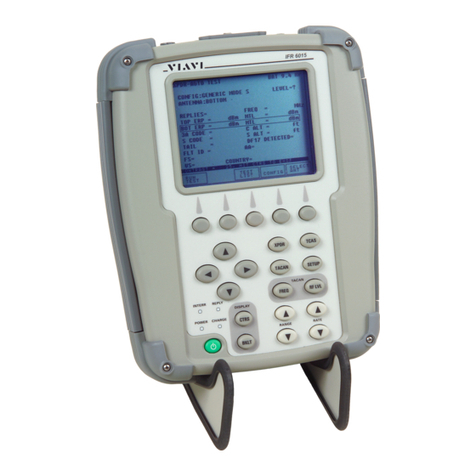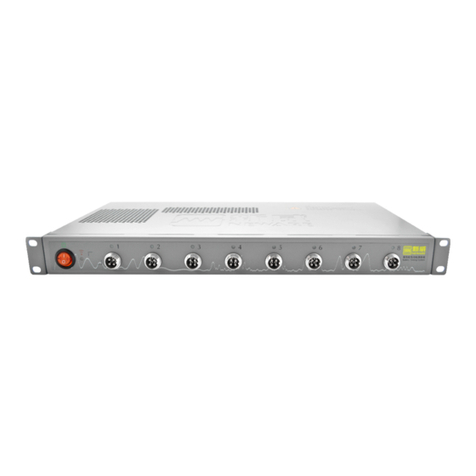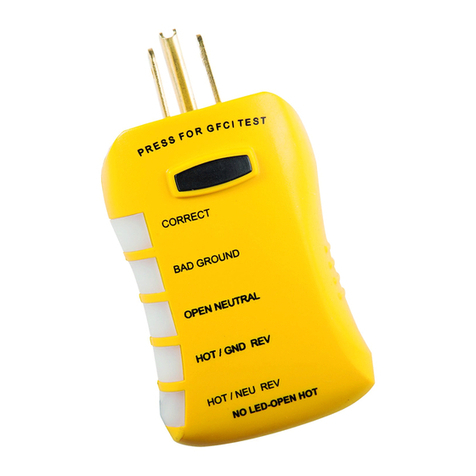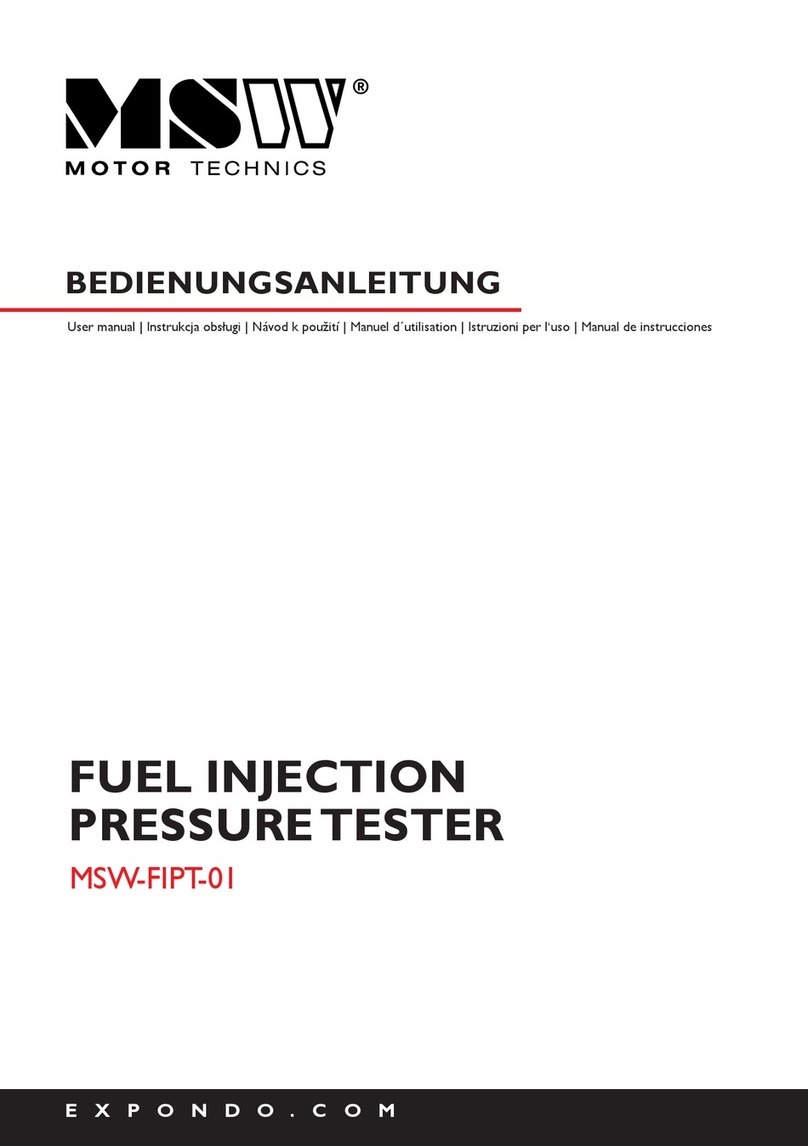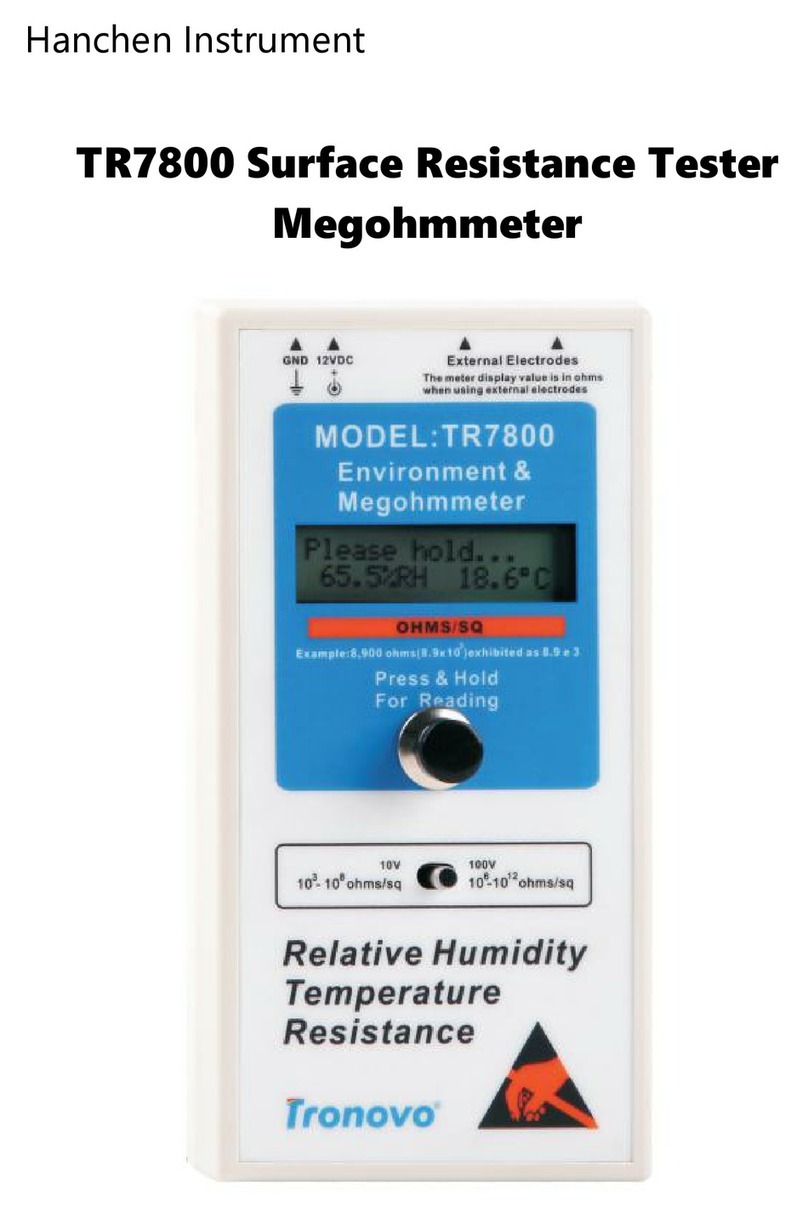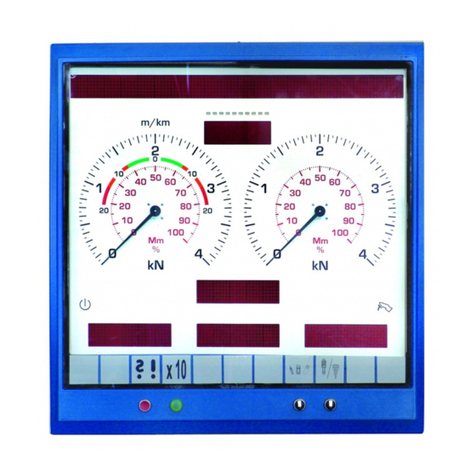DeFelsko PosiTector SST User manual

Quick Guide v. 1.0
The Measure of Quality
Soluble Salt Tester

The Bresle Method DeFelsko Patch is low cost, latex-free,
and works on nearly any surface geometry or material.
It features a low-tack adhesive which creates a
tight seal while remaining easy to remove without
leaving behind any foam residue.
The Bresle Method DeFelsko PosiPatch further simplifies the
Bresle method. It requires no adhesive, as it is held to a steel
surface by a magnetic holding ring. It has a built-in port
which allows
deionized (DI) water to be injected
using a dull polypropylene dispensing tube,
eliminating sharp needles from the test. It
features a patented air-permeable membrane,
which automatically releases trapped air as DI
water is injected, then allows air bubbles to return
and agitate the surface as solution is withdrawn. It is also
reusable, and a single PosiPatch can be used for multiple tests.
The PosiTector SST can be used as a conventional conductivity
meter making it ideal for testing abrasive materials in accordance
with ISO 11127-6 and ASTM D4940-15. See Bresle Mode (pg. 9)
This Quick Guide summarizes the basic functions of the gage.
Download the full instruction manual at www.defelsko.com/manuals
Recommended: PosiTector SST Video -
www.defelsko.com/sst/video
Introduction
The PosiTector Soluble Salt Tester (SST) is a hand-held
electronic instrument that measures the conductivity of a solution
and calculates the concentration of water-soluble salts on metal
surfaces in accordance with ISO 8502-6 (the Bresle Method) and
ISO 8502-9. It consists of a PosiTector body (Standard or
Advanced) and an interchangeable probe
The PosiTector SST is compatible with all Bresle Method-type
patches including the Bresle Method DeFelsko PosiPatch, Bresle
Method DeFelsko Patch and other adhesive patches. While
compatible with any test patch, there are numerous advantages
to the DeFelsko patch solutions.
1

PosiTector SST
probes consist of a purpose-built test cell, optimized
for the range, resolution and test volume of the Bresle Method.
Conductivity measurements are compensated to 25°C
(77°F) using a built-in temperature sensor, and the
sample temperature is recorded for each measurement.
The probe can be used as a conventional conductivity
meter by unchecking Bresle Mode (pg. 9).
When powered-up, the PosiTector automatically
determines which probe is attached and does a self-check.
To disconnect disconnect a probe from a body, slide the
plastic probe connector horizontally (in the direction of the
arrow) away from the body. Reverse these steps to attach
a different probe. It is not necessary to power-down the
Gage when switching probes.
To navigate, use the Up and Down buttons to scroll vertically
and to SELECT.
Menu Operation
Press the (+)button to switch
pages in a multipage menu
Press the
(-)
button to return to
the previous menu or page.
Select Exit to exit from any menu.
Test
Cell
2
Basic Operation
The PosiTector SST powers-up when the center navigation
button is pressed. To preserve battery life, the Gage powers
down after approximately 5 minutes of no activity (15 minutes
while in Bresle Mode (pg. 9). Alternatively, select Power Off
from the menu. All settings are retained.
Gage functions are menu controlled. To access the Menu,
power-up the gage, then press the center navigation button.
Probes
The PosiTector gage body accepts a wide variety of probe
types including magnetic, eddy-current and ultrasonic coating
thickness, surface profile, environmental, Shore hardness
durometer and ultrasonic wall thickness probes.
See www.defelsko.com/probes

3
How To Measure
Test Preparation:
Use deionized (DI) water to thoroughly clean the PosiTector SST
test cell, test cup, syringe and PosiPatch (if used in test).
All test materials should be handled in a manner that minimizes
the potential for contamination. The PosiTector SST operator may
choose to wear nitrile or other non-contaminating gloves when
performing the test.
Remove the protective rubber cap from the probe. Power-up the
Gage by pressing the center navigation button.
In the default Bresle Mode, the Gage guides you through three
simple steps –
[1], [2], and [3].
Step
[1]:
Obtain Background (Blank) Conductivity Measurement (γ1)
NOTE: The Gage automatically displays the previous background
measurement, if any. This measurement can be reused and step
(c) to step (e) can be skipped by pressing the (
-
) button.
a) Pour at least 4ml (milliliters) of deionized (DI) water into the
supplied cup (to prevent contamination of the water source).
b) Fill the syringe completely with DI water from the cup (slightly
more than 3ml).
c) Completely fill the PosiTector SST probe’s test cell with water
from the syringe (approximately 1ml).
d) Wait until the measurement stabilizes (up to 5 seconds),
then press the (+) button to save a new background conductivity
measurement (
γ
1) and the water temperature (T1).
e) Use the syringe to draw all of the water from the test cell.
Shake any remaining water out of the test cell.
f) With the syringe pointing up, expel the air and excess solution
from the syringe until there is 3.0ml of DI water remaining.

Step
[2]:
Prepare Bresle Method Patch
Option A: DeFelsko PosiPatch
a) Turn the PosiPatch and magnetic ring upside down. Place
the PosiPatch into the magnetic ring ensuring the arrows align
with the injection port. Do not touch the PosiPatch’s interior.
b) Carefully place the magnetic ring on the steel surface.
When used on vertical surfaces, position the port between the
2 o’clock and 10 o’clock points before attaching the ring to the
surface.
c) Slowly inject 3.0ml of DI water into the port using the plastic
dispensing tip. The air within the PosiPatch automatically
escapes through the air-permeable membrane
4
(a) (b) (c)
When used on horizontal surfaces, fully insert the dispensing tip
into the PosiPatch. On vertical surfaces, insert the dispensing tip
only as far as is needed to see the tip inside the PosiPatch.
Option B: Bresle Method DeFelsko Patch (or equivalent)
a) Remove the backing and foam center from the patch, taking
care not to touch the interior surface.
b) Press the patch firmly onto the surface making sure most of
the air escapes.
c) Pierce the top of the patch at the foam perimeter, allowing
the needle to penetrate into the center of the patch.

5
d) Inject half of the water into the patch. Then, use the syringe
to withdraw trapped air.
e) Remove the needle, point it upwards and expel the air.
f)
Re-insert the needle and inject the remaining water into the patch.
Step
[3]:
Begin Test (applies to both patch styles)
a) Once the water is injected into either patch,
press the (+)button to start the test timer.
After starting the test timer, the operator can select Power Off
from the Gage menu to conserve battery life. The test timer will
continue to run and the elapsed test time will be displayed when
the Gage is powered-up.
b) Without removing the needle/dispensing tip from the patch,
use the syringe to repeatedly withdraw and inject the water. ISO
8502-6 recommends this process be completed at least four
times and that the test time be agreed between interested parties.
c) After the desired amount of time has elapsed, withdraw the
solution from the patch.
d) To complete the measurement, completely fill the PosiTector
SST probe’s test cell with the solution from the patch. Wait until
the measurement stabilizes(up to 5 seconds), then press the (+)
button to save the temperature (T2) and conductivity (
γ
2) of the
solution. ∆
γ
, the difference between the
γ
2soluble salt reading
and the
γ
1background reading, is displayed.
(a) (b) (c)
TIP:

t= test duration
T2= sample temperature
∆
γ
= The change in conductivity. The
initial background measurement (
γ
1)
is automatically subtracted from the
final measurement (
γ
2) Test results
are displayed in units of microsiemens
per centimeter (conductivity).
ρA=The surface density of soluble
salt expressed as sodium chloride.
Test results are displayed in units of
milligrams per square meter, or
micrograms per square centimeter.
If a memory batch is open, the measurement result will be stored
in memory (pg. 9).
e) Press the (+) button to begin a new test.
Patch Removal
The Bresle Method DeFelsko Patch peels off the surface easier
and with less residue than conventional Bresle patches. Remove it
immediately after the test and dispose.
The Bresle Method PosiPatch lifts
cleanly off the surface, with absolutely
no residue. The user may choose to
discard the PosiPatch and begin the
next test with a new one, or simply
rinse it with DI water and reuse for
several more tests until worn.
Rinsing the Test Cell
Rinse the test cell with unused DI water
several times after each measurement,
shaking the water out after each rinse.
6

7
Calibration, Verification, and Adjustment
Three steps ensure best accuracy…
1. Calibration: typically performed by the manufacturer. All probes
include a Certificate of Calibration.
2. Verification of Accuracy: typically performed by the user
by measuring known reference standards such as the supplied
conductivity standard.
3. Adjustment: to a known conductivity standard
.
Calibration - Calibration is the high-level, controlled and
documented process of measuring traceable calibration standards
over the full operating range of the probe, and verifying that the
results are within the stated accuracy of the probe. Calibrations
are performed by the manufacturer, their authorized agent, or by
an accredited calibration laboratory in a controlled environment
using a documented process.
Verification of Accuracy - Verification is an accuracy check
performed by the user with a solution of known conductivity. To
perform a verification, ensure that the conductivity standard and
instrument are at the same temperature. Remove any remaining
DI water in the test cell by filling it with the conductivity standard,
then inverting the test cell to empty it. Fill the test cell with the
conductivity standard again. If the reading is not within the
combined tolerance of the gage and conductivity standard,
proceed to Cleaning the Test Cell, below.
Cleaning the Test Cell - If the Verification reading is outside the
combined accuracy of the conductivity standard and gage, the
probe may need to be cleaned by filling it with DI water and rubbing
the walls of the cell with a supplied foam tip swab. Rinse with DI
water several times before using the cell.
Verify accuracy at the beginning and the end of each work shift.
During the work shift, if the Gage is dropped or suspected of giving
erroneous readings, its accuracy should be re-verified.
Adjustment - Adjustment, or Calibration Adjustment, is the act of
aligning the Gage’s readings to match that of a known conductivity
standard. (see Cal Adjust, pg. 9)

Reset (menu Reset) restores factory settings and returns the
Gage to a known condition. The following occurs:
-
All batches, stored measurements, batch names and screen
captures are erased.
-
Calibration adjustments are returned to factory settings.
-
The last stored background measurement (
γ
1) is erased.
-
Menu settings are returned to the following:
1. Power down the Gage and wait 5 seconds.
2. Simultaneously press and hold the (+)and center
buttons until the Reset symbol appears.
This returns the Gage to a known, “out-of-the-box” condition.
Set the volume of water being used for the test (3.0ml default).
Use the (
-
)(+) buttons to decrease/increase the displayed value.
The patch volume is used to calculate surface density.
Patch Volume
8
Reset
Setup Menu
Memory = OFF
Bresle Mode = ON
Auto Dim = ON
Display = None
Patch Volume = 3.0ml
Bluetooth & Stream = OFF
WiFi & Access Point = OFF
Surface Density units = mg/m2
Temperature units = °C
Hi Res = OFF
Units
Allows the operator to change the displayed units for both
Temperature (°C or °F) and Surface Density (mg/m2or µg/cm2).
Perform a more thorough Hard Reset as follows:
Flip Display = Normal
Backlight = Normal
Auto Sync .net = ON
White on Black = ON
Sound = ON
Language = English
Battery Type = Alkaline
Bluetooth Smart = OFF
USB Drive = ON
It performs the same function as a menu Reset with the addition of:
-
Bluetooth Pairing info is cleared.
-
Menu settings are returned to the following status:
-
Date, Time and WiFi settings are not affected by either Reset.
NOTE:

The PosiTector SST can be adjusted to a known conductivity
standard. Use the (
-
)(+) buttons to decrease/increase the
displayed value to match the known conductivity of the standard.
In typical use, a calibration adjustment should not be
required. Before performing the adjustment, ensure that the
PosiTector SST test cell has been thoroughly cleaned with
DI water. Ensure that the conductivity standard and
PosiTector SST test cell are at the same temperature.
Cal Adjust
When checked
(default),
the Gage guides the user through a 3-step
test process in accordance with
ISO 8502-6.
Uncheck Bresle Mode
to use the PosiTector SST as a regular conductivity meter such as
when testing abrasive materials in accordance with ISO 11127-6
and ASTM D4940-15.
Bresle Mode
Selects the type of batteries used in the Gage from a choice of
“Alkaline”, “Lithium” or “NiMH” (nickel-metal hydride rechargeable).
If “NiMH” is selected, the Gage will trickle charge the batteries while
connected via USB to a PC or optional AC power supply (USBAC).
The battery state indicator symbol is calibrated for the selected
battery type. No damage will occur if the battery type used in the
Gage does not match the selected battery type.
Battery Type
The PosiTector SST has internal memory storage for recording
measurement data. Stored measurements can be reviewed on-
screen or accessed via computers, tablets and smart phones.
All stored measurements are date and time-stamped.
The symbol appears when the Gage is set to store
measurement data.
Memory Management
9
Increases the displayed Gage resolution as follows:
0.1 µS, 0 - 200 µS
1.0 µS, over 200 µS
Gage accuracy is not affected.
Hi Res
NOTE:
NOTE:
(Calibration Adjustment)

10
Screen Capture
Press both the (
-
)and (+)buttons at any time to capture and save
an image copy of the current display. The last 10 screen captures
are stored in memory and can be accessed when connected to a
computer (see PosiSoft USB Drive, pg. 10).
Accessing Stored Measurement Data
DeFelsko offers the following free solutions for viewing, analyzing
and reporting data:
PosiSoft USB Drive - Connect the Gage to a PC/Mac using the
supplied USB cable. View and print readings and graphs using
universal PC/Mac web browsers or file explorers. No software or
internet connection required. USB Drive must be selected in the
Gage’s “Connect > USB” menu (pg. 11).
PosiSoft Desktop - Powerful desktop software (PC/Mac) for
downloading, viewing, printing and storing measurement data.
Includes a customizable, templated PDF Report Generator. No
internet connection required.
PosiSoft.net - Web-based application offering secure, centralized
storage of measurement data. Access your data from any web-
connected device.
PosiTector App - (Advanced models only, serial numbers 784000+)
App for compatible iOS and Android smart devices. Permits users
to create, save and share professional PDF reports. Add images
and notes using the smart device’s camera and keyboard.
For more information on our PosiSoft solutions, see:
www.defelsko.com/posisoft
Advanced models store 100,000 readings in up to 1,000
batches. “New Batch” closes any currently opened batch and
creates a new batch name using the lowest available number.
New batch names are date-stamped when they are created.
Standard models store up to 250 readings in one batch.

The above WiFi,USB and Bluetooth menus contain a Sync .net
Now option. When selected, the Gage immediately synchronizes
stored measurement data via its respective communication
method (internet connection required). Alternatively, select Auto
Sync .net from within the USB connect menu to automatically
synchronize upon connection to a PC. Additional measurements
added to memory while connected are synchronized only when
the USB cable is disconnected and reconnected, or when the
Sync.net Now option is selected. WiFi connected gages
automatically attempt synchronization upon power-up.
Sync .net Now
Connect Menu
When USB Drive is checked , the PosiTector gage uses
a USB mass storage device class which provides users with a
simple interface to retrieve stored data in a manner similar to
USB flash drives, digital cameras and digital audio players.
USB Drive is also required to import stored measurements into
PosiSoft Desktop software (pg. 10).
When connected, power is supplied through the
USB cable. The batteries are not used and the body will not
automatically power down. If rechargeable (NiMH) batteries
are installed, the instrument will trickle charge the batteries.
Allows individual readings to be sent to a computer, printer or
compatible device as they are taken using Bluetooth wireless
technology. See www.defelsko.com/bluetooth
Bluetooth (Advanced models only)
Allows connection to your local wireless network or mobile
hot spot. Ideal for using your network’s internet connection for
synchronizing stored measurements with PosiSoft.net (pg. 10).
See www.defelsko.com/wifi
WiFi (Advanced models only)
NOTE:
USB
PosiSoft Desktop Manager is required when using
USB or Bluetooth connections to synchronize measurements
with PosiSoft.net.
NOTE:
11

12
Sync Batches
Select batches to flag them for synchronization to the
PosiTector App. New batches created while Bluetooth Smart
is enabled are automatically selected.
With Bluetooth Smart enabled, select Sync Batches to transfer
selected batches to the PosiTector App. This is useful when
switching between smart devices, as only readings and batches
that have yet to be synchronized with any smart device are
synchronized automatically.
The Gage will perform a Hard Reset (pg. 8) after
an update. All stored measurements will be erased from memory.
Updates
Determine if a software update is available for your Gage.
See www.defelsko.com/update
WARNING:
When Enabled , allows communication with a smart device
running the PosiTector App (pg. 10) via auto-pairing Bluetooth
Smart (BLE) wireless technology.
Bluetooth Smart (Advanced models only,
serial numbers 784000 and greater)
Send Batches
Transfers selected batches to the PosiTector App (useful
when switching between devices).
The Send Batches option is visible in the Bluetooth Smart
menu when the Gage is connected to a smart device running
the PosiTector App.
If Bluetooth Smart is disabled, data from batches
selected in the Sync Batches menu are held in a queue until
communication with the PosiTector App is re-established.
NOTE:

www.defelsko.com
© 2016 DeFelsko Corporation USA
All Rights Reserved
This manual is copyrighted with all rights reserved and may not be reproduced or transmitted, in whole
or part, by any means, without written permission from DeFelsko Corporation.
DeFelsko, PosiSoft and PosiTector are trademarks of DeFelsko Corporation registered in the U.S. and
in other countries. Other brand or product names are trademarks or registered trademarks of their
respective holders.
Every effort has been made to ensure that the information in this manual is accurate. DeFelsko is not
responsible for printing or clerical errors.
Returning for Service
Before returning the instrument for service…
1. Install new or newly recharged batteries in the proper
alignment as shown within battery compartment.
2. Examine the probe for damage. Use the supplied cleaning
tool to clear dirt or debris from the test cell.
3. Perform a Hard Reset (pg. 8).
4. If issue is not resolved, Update (pg. 12) your PosiTector
gage body and re-attempt measurements.
IMPORTANT:
If you must return the Gage for service, please fill out and
include the Service Form located at www.defelsko.com/support
with the Gage. Be sure to also include the probe, your company
name, company contact, telephone number and fax number or
email address.
Limited Warranty, Sole Remedy
and Limited Liability
DeFelsko's sole warranty, remedy, and liability are the express
limited warranty, remedy, and limited liability that are set forth on
its website: www.defelsko.com/terms
13

The Measure of Quality
Soluble Salt Tester
Guía rápida v. 1.0

Introducción
El PosiTector Soluble Salt Tester (
SST
) es un instrumento
electrónico portátil que mide la concentración de una solución y
calcula la concentración de sales solubles en superficies de metal
de acuerdo con la norma ISO 8502-6 (método Bresle) e ISO 8502-9.
Se compone de una base PosiTector (Standard o Advanced) y una
sonda intercambiable.
El
PosiTector SST
es compatible con todos los parches para el
método Bresle incluyendo el PosiPatch DeFelsko para método
Bresle, los parches para método Bresle DeFelsko y otros parches.
Al tiempo que es compatible con cualquier parche de prueba, presenta
numerosas ventajas con las soluciones de parches DeFelsko.
1
El Parche DeFelsko para método Bresle tiene un bajo
coste, no contiene látex, y funciona en casi cualquier
geometría de la superficie o material. Cuenta con un
adhesivo de baja adherencia que crea un sello hermético que
es fácil de quitar sin dejar ningún residuo de espuma.
El PosiPatch DeFelsko para método Bresle simplifica aún más la
prueba. No requiere ningún adhesivo, ya que está unido a una
superficie de acero por un anillo de retención magnética.
Dispone de un punto de entrada de agua desionizada
(DI) que se inyecta usando una cánula de dosificación
de polipropileno de punta roma eliminando las agujas
punzantes de la prueba. Cuenta con una membrana
permeable al aire patentada que libera automáticamente
el aire de su interior cuando se inyecta agua desionizada, lo que
permite que las burbujas de aire retornen y agiten la superficie al
extraer la solución. Tiene varios usos y un solo PosiPatch puede
utilizarse para múltiples pruebas.
El PosiTector SST puede utilizarse como un medidor de
conductividad convencional, lo que es ideal para pruebas de
materiales abrasivos según ISO 11127-6 y ASTM D4940-15.
Consulte Modo Bresle (pág. 8).
Esta guía rápida recoge las funciones básicas del medidor.
Descargue el manual de instrucciones completo en
www.defelsko.com/manuals.
Recomendado: Vídeo PosiTector SST: www.defelsko.com/sst/video

Sondas
Una vez encendido, el PosiTector determinará automáticamente el tipo
de sonda conectado y realizará una comprobación automática.
Para desconectar una sonda de la base del PosiTector
deslíce el conector de la sonda de plástico horizontalmente
(en la dirección de la flecha)
separándola de la base
PosiTector
.
Invierta los pasos para conectar una sonda diferente. No es
necesario apagar el medidor cuando se cambia la sonda.
La base del medidor PosiTector acepta una amplia variedad
de tipos de sonda incluyendo las necesarias para medir espesor
de recubrimientos tipo magnético, de corrientes de Foucault
y de ultrasonido; sondas para perfiles de superficie, ambiental, dureza
Shore y sondas de espesor de pared por ultrasonidos. Consulte
www.defelsko.com/probes
Las sondas PosiTector SST son celdas de ensayo especialmente
diseñadas y optimizadas para el intervalo, resolución y
volumen de prueba del método Bresle. Las mediciones
de conductividad se compensan a 25°C (77°F) utilizando
un sensor de temperatura incorporado registrándose la
temperatura de la muestra para cada medición. La sonda
puede utilizarse como un medidor de conductividad
convencional desactivando el Modo Bresle (pág.8).
El PosiTector SST se enciende al pulsar el botón central . Para
preservar la vida de la batería, el medidor se apagará tras unos 5 minutos
sin actividad (15 minutos en el Modo Bresle, pág. 8). Como alternativa,
seleccione Apagar en el menú. Se conservarán todas las configuraciones.
Funcionamiento Básico
Menú Operación
Las funciones del medidor se controlan con un menú. Para acceder al
menú encienda el medidor y pulse el botón central.
Presione el botón (+) para cambiar
de página en el menú formado de
varias páginas.
Presione el botón (
-
)para regresar
al menú o página anterior.
Seleccione Salir para cerrar el
menú del medidor.
Para desplazarse utilice los botones Arriba y Abajo y para
SELECCIONAR.
Celdas de ensayo
2

3
Cómo medir
Retire el tapón protector de goma de la sonda. Encienda el medidor
pulsando el botón central . En el modo por defecto
Bresle
,el
medidor le guiará a través de tres pasos muy simples
–
[1], [2],y[3].
Paso
[1]:
Obtener la medición (γ1) de la conductividad de fondo
(en blanco)
NOTA:
El medidor mostrará de manera automática la medición de
fondo anterior, si hubiera. Esta medición podrá volver a utilizarse y
podrá omitir los pasos de
(c)
a
(e)
presionando el botón (-).
a)
Vierta al menos 4ml (mililitros) de agua desionizada (DI) en el
recipiente para evitar la contaminación de la fuente de agua.
b)
Llene completamente la jeringa con el agua del recipiente.
c)
Llene completamente la celda de prueba de la sonda del
PosiTector SST
con el agua de la jeringa.
d)
Pulse el botón (+) para guardar una nueva medición de la
conductividad de fondo
(
γ
1)
y la temperatura del agua
(T1)
.
e)
Utilice la jeringa para extraer toda el agua de la celda de prueba.
Elimine cualquier resto de agua de la celda de prueba.
f)
Expulse el aire y el exceso de solución de la jeringa apuntando
hacia arriba hasta que queden 3ml.
Paso
[2]:
Preparar el método Bresle
Opción A: PosiPatch DeFelsko
a)
Gire el PosiPatch y el anillo magnético dejando su cara superior
hacia abajo. Coloque el PosiPatch en el anillo magnético alineando las
flechas con el punto de inyección. No toque el interior del PosiPatch.
b) Coloque con cuidado el anillo magnético sobre la superficie de acero.
c)
Inyecte lentamente el agua en el punto de entrada utilizando la
cánula de plástico. El aire del interior del PosiPatch se escapará
automáticamente a través de la membrana permeable al aire.
(a) (b) (c)

Opción B: Parche para método Bresle DeFelsko (o equivalente)
a)
Retire el refuerzo y el centro de espuma del parche con cuidado
de no tocar la superficie interior.
b)
Presione el parche firmemente contra la superficie asegurándose
de que sale la mayor parte del aire.
c) Perfore la parte superior del parche en el marco de espuma,
permitiendo que la aguja llegue al centro del parche.
4
(a) (b) (c)
d)
Inyecte la mitad del agua en el parche. A continuación utilice
la jeringa para extraer el aire del interior.
e)
Retire la aguja, apunte hacia arriba y expulse el aire.
f)
Vuelva a insertar la aguja e inyecte el agua restante en el parche.
Paso
[3]:
Iniciar la prueba (aplica a ambos estilos de parche)
a)
Una vez que haya inyectado el agua en cada parche, pulse el
botón (
+
) para iniciar el temporizador de prueba.
b)
Sin retirar la aguja o cánula del parche, utilice la jeringa para
expulsar e inyectar el agua repetidamente. La ISO 8502-6
recomienda completar este proceso al menos cuatro veces y que
el tiempo de prueba se determine entre las partes interesadas.
c)
Transcurrido el período de tiempo deseado, extraiga la solución
de parche.
d)
Para completar la medición, llene completamente el medidor de
celda de la sonda
PosiTector SST
con la solución del parche y
pulse el botón (
+
) para guardar la temperatura
(T2)
y la
conductividad
(
γ
2)
de la solución. Aparecerá
∆
γ, la diferencia
entre la lectura de sal soluble γ
2
y la lectura de fondo γ
1
.

t
= tiempo de prueba transcurrido
T2= temperatura de la solución
de prueba
∆
γ= cambio en la conductividad.
Automáticamente se restará la
medición de fondo inicial (γ
1
) de la
medición final (γ
2
) y los resultados
de la prueba se mostrarán en
unidades de microsiémens por
centímetro (conductividad).
ρ
A
= Densidad superficial de sal
soluble expresada como cloruro de
sodio. Los resultados de la prueba
se mostrarán en unidades de miligramos por
metro cuadrado, o microgramos por centímetro cuadrado.
Si estuviera abierto un lote de memoria el resultado de la medición
quedará almacenado (pág. 8).
e)
Pulse el botón (
+
) para comenzar una nueva prueba.
Retirada del parche
El Parche para método Bresle
DeFelsko se despega de la
superficie con mayor facilidad y menos residuos que los parches
Bresle convencionales. Retírelo inmediatamente después de la
prueba y deséchelo.
El
PosiPatch
para método Bresle se despega limpiamente de la
superficie, sin ningún residuo. El usuario podrá elegir entre desechar
el PosiPatch y comenzar la siguiente prueba con uno nuevo o
simplemente aclararlo con agua desionizada y reutilizarlo para varias
pruebas más, hasta su deterioro.
Aclarado de la celda de prueba
Aclare la celda de prueba con agua desionizada después
de cada medición.
5
Other manuals for PosiTector SST
3
Table of contents
Languages:
Other DeFelsko Test Equipment manuals
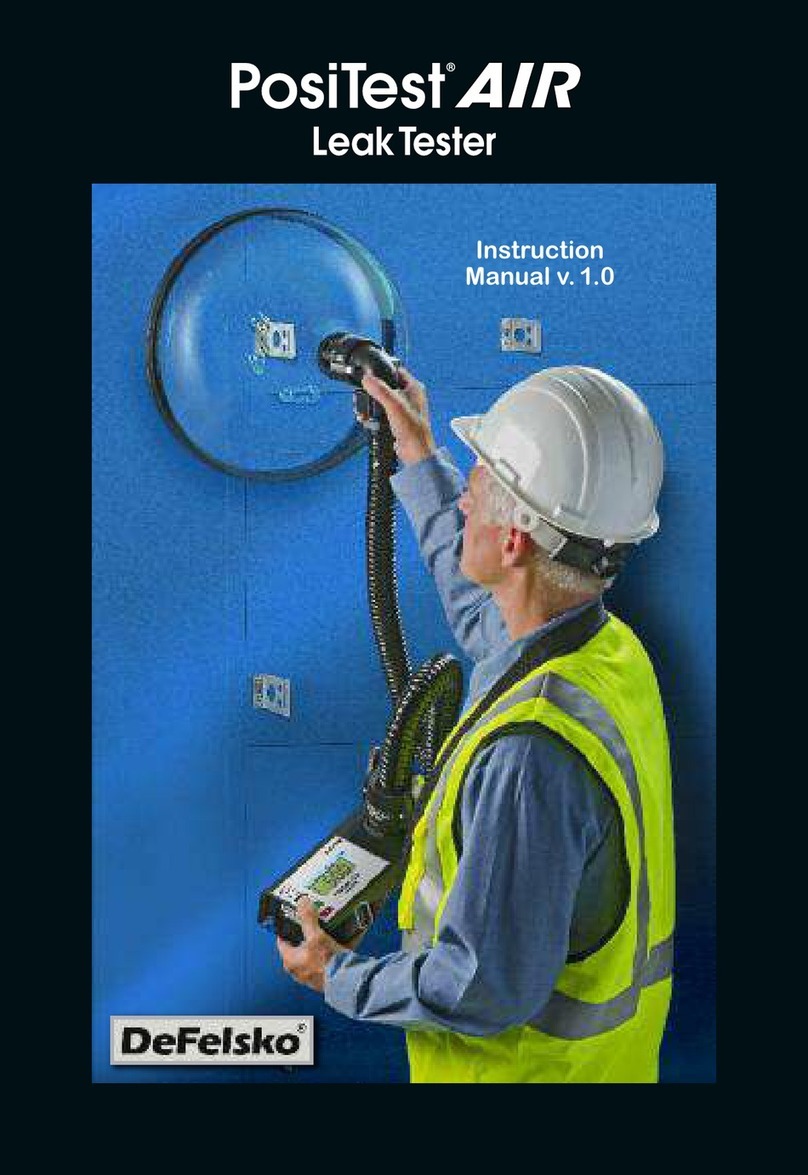
DeFelsko
DeFelsko PosiTest AIR User manual
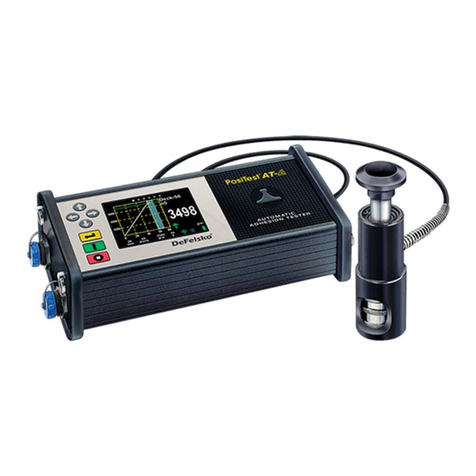
DeFelsko
DeFelsko PosiTest AT-A User manual

DeFelsko
DeFelsko PosiTector 6000 FNDS Installation and operating instructions

DeFelsko
DeFelsko PosiTest AT-A User manual
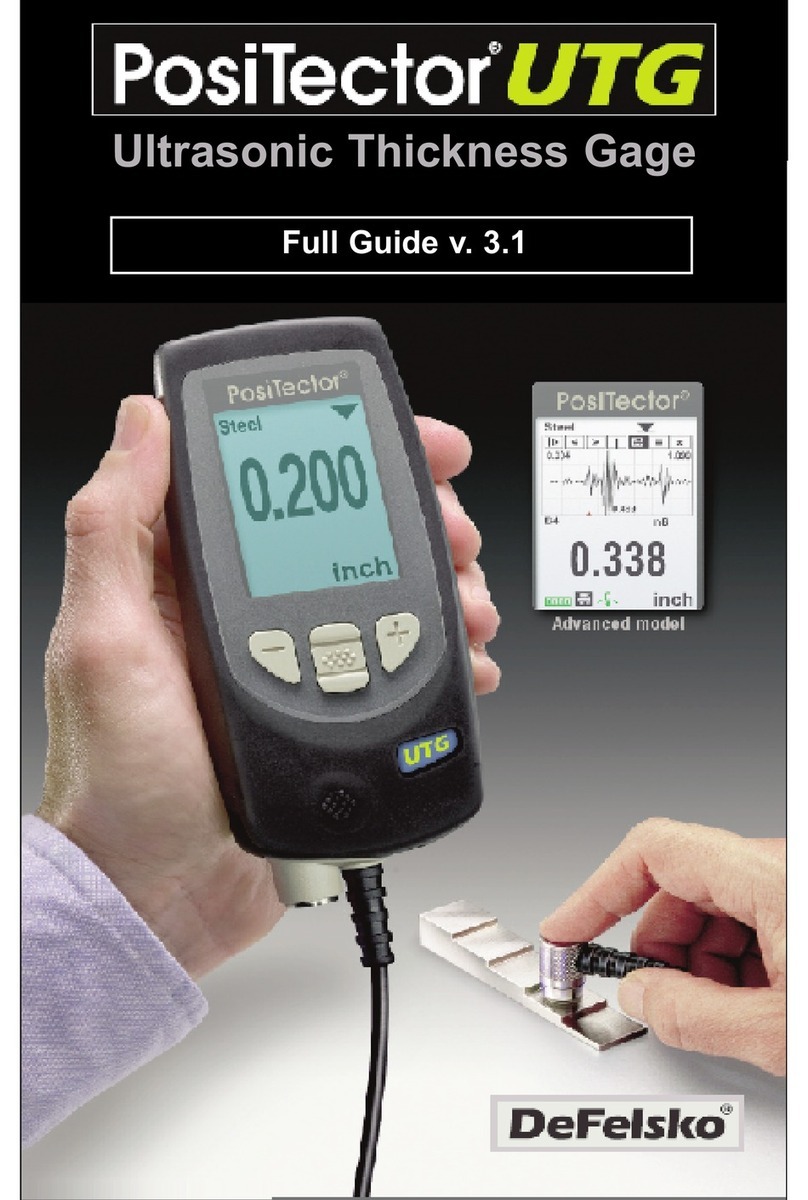
DeFelsko
DeFelsko PosiTector UTG User manual

DeFelsko
DeFelsko PosiTector SPG User manual
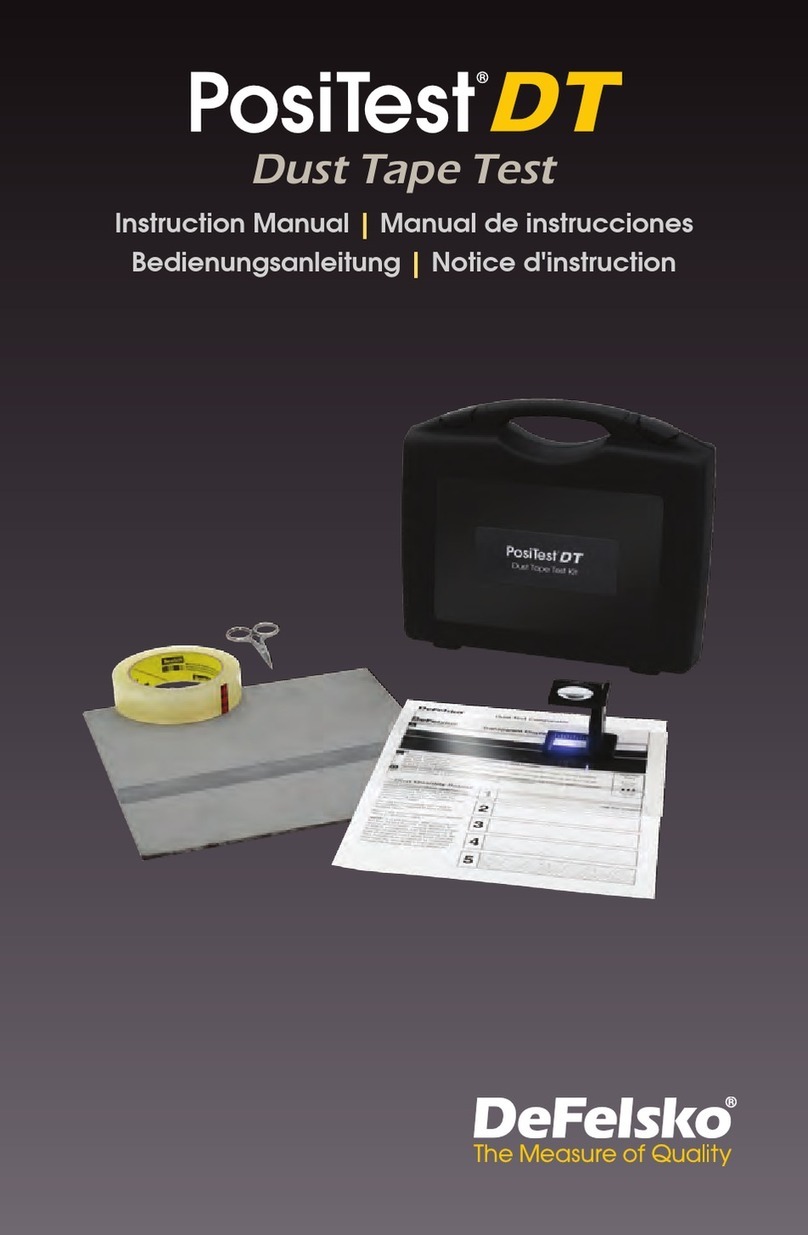
DeFelsko
DeFelsko PosiTest DT User manual
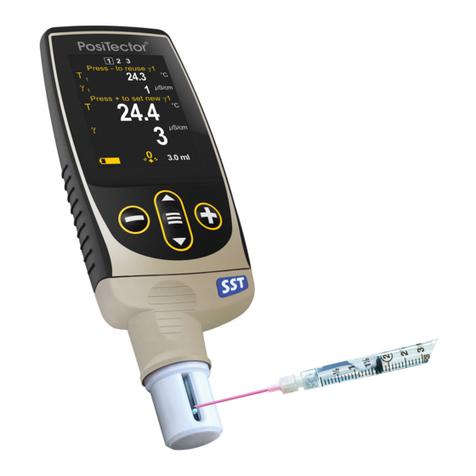
DeFelsko
DeFelsko PosiTector SST User manual

DeFelsko
DeFelsko PosiTest AIR User manual
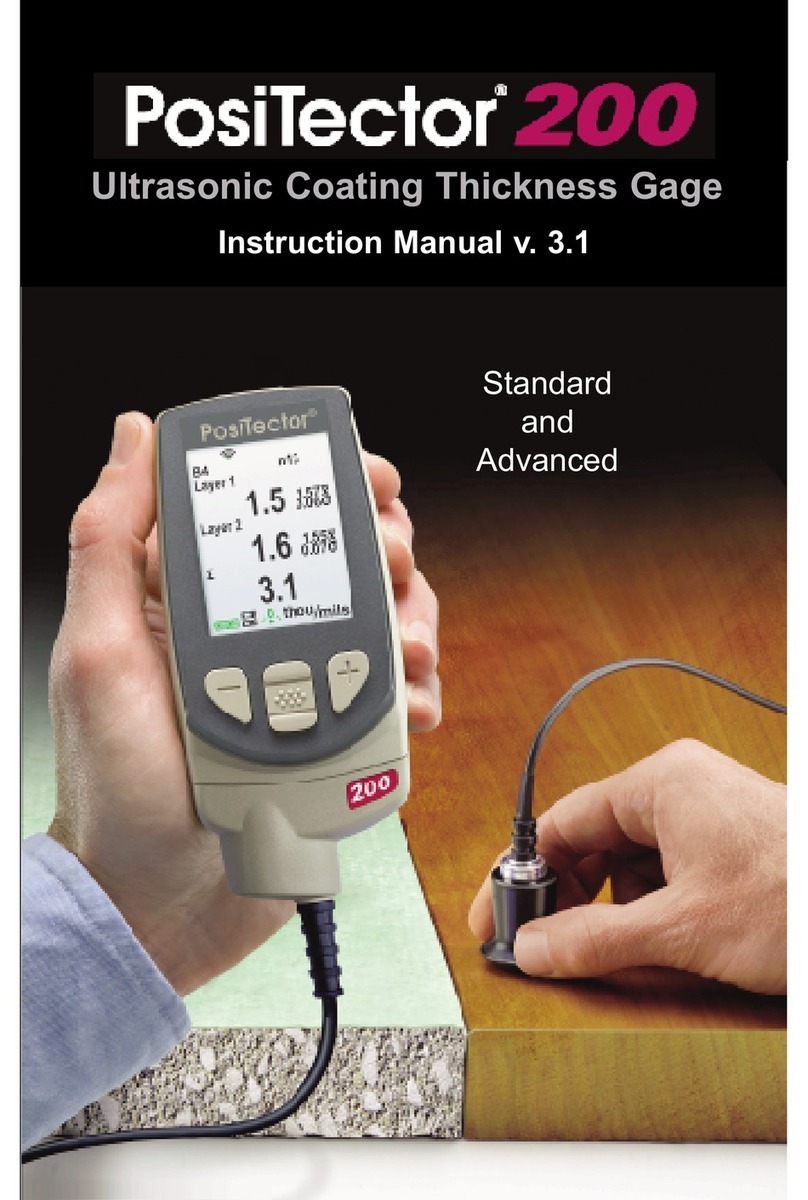
DeFelsko
DeFelsko PosiTector 200 User manual

